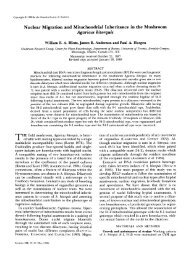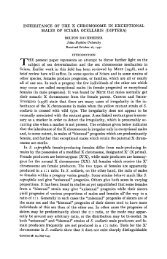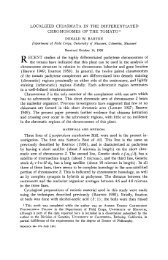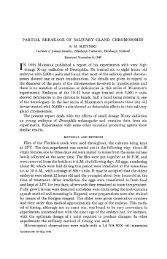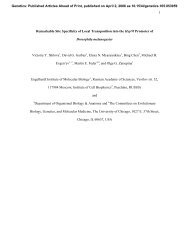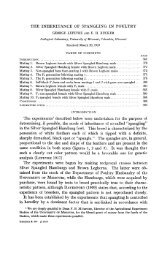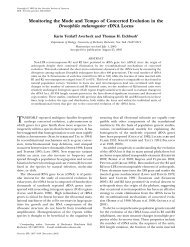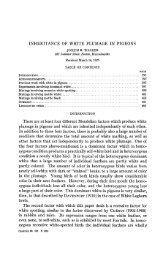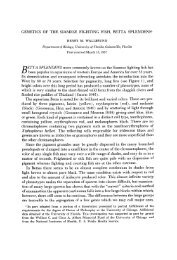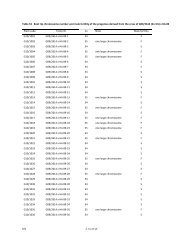abstracts of papers presented at the 1962 meetings - Genetics
abstracts of papers presented at the 1962 meetings - Genetics
abstracts of papers presented at the 1962 meetings - Genetics
Create successful ePaper yourself
Turn your PDF publications into a flip-book with our unique Google optimized e-Paper software.
ABSTRACTS 9 79<br />
RBDEI, G. P., University <strong>of</strong> Missouri, Columbia, MO.: Genetic block <strong>of</strong> “uitamin thiazole” syn<strong>the</strong>sis<br />
in Arabidopsis.-An X-ray-induced recessive mut<strong>at</strong>ion (tz) interferes with <strong>the</strong> syn<strong>the</strong>sis<br />
<strong>of</strong> <strong>the</strong> thiazole moiety <strong>of</strong> vitamin B,. The mutants germin<strong>at</strong>e but die befare <strong>the</strong> appearance<br />
<strong>of</strong> rosette leaves unless 4-methyl-5-P-hydroxyethylthiazole (TZ) is supplied in an aseptic agar<br />
medium or into <strong>the</strong> soil. A supplement <strong>of</strong> 0.1 microgram TZ per five ml medium restores full<br />
viability and normal growth. The paucity <strong>of</strong> TZ involves a special chlorophyll defect characteristic<br />
for thiamin (TH) deficiency. TH substitutes well for TZ. The pyrimidine moiety <strong>of</strong> TH,<br />
2,5-dimethyl-4-aminopyrimidine (PY) is completely inactive however. The antimetabolite oxythiamine<br />
(4-NH2 group <strong>of</strong> PY is replaced by OH), which contains an appropri<strong>at</strong>e TZ, also s<strong>at</strong>isfies<br />
<strong>the</strong> requirement though in an amount about a hundred times larger.-Ano<strong>the</strong>r <strong>of</strong> our Arabidopsis<br />
mutants (py) is blocked in PY syn<strong>the</strong>sis (<strong>Genetics</strong> 45:1007), while LANGRIDGE reported<br />
(Australian J. Biol. Sci. 11 : 58) a third which is involved in <strong>the</strong> coupling <strong>of</strong> PY to TZ and consequently<br />
responds to added TH only. Thus <strong>the</strong> completeness <strong>of</strong> inform<strong>at</strong>ion about <strong>the</strong> genetic<br />
control <strong>of</strong> vitamin B, syn<strong>the</strong>sis in <strong>the</strong> higher plant Arabidopsis compares favorably with th<strong>at</strong> <strong>of</strong><br />
Neurospora.<br />
REMINGTON, CHARLES L., Yale University, New Haven, Conn.: <strong>Genetics</strong> <strong>of</strong> mimetic characters<br />
in <strong>the</strong> genus Limenitis (Lepidoptera).-The butterfly genus Limenitis in North America includes<br />
five closely rel<strong>at</strong>ed but phenotypically unlike species. Two (L. archippus and L. astyanaz) are<br />
mimics <strong>of</strong> unrel<strong>at</strong>ed distasteful butterflies, and a third (L. lorquini) probably is also mimetic<br />
in color and p<strong>at</strong>tern. L. archippus has three distinctive races, each resembling a different model<br />
species or race. The o<strong>the</strong>r two species resemble Old World rel<strong>at</strong>ives and probably have <strong>the</strong> color<br />
and p<strong>at</strong>tern formerly possessed by <strong>the</strong> presently mimetic species. By <strong>the</strong> technique d hand-pairing,<br />
several <strong>of</strong> <strong>the</strong> possible F, hybrids and backcrosses have been made. The conspicuous mimetic<br />
color characters prove to be under simple Mendelian control. An objection to <strong>the</strong> mimicry hypo<strong>the</strong>sis<br />
is based on <strong>the</strong> presumption th<strong>at</strong> numerous small hereditary changes would have been<br />
required in <strong>the</strong> evolution <strong>of</strong> <strong>the</strong> mimic, with <strong>the</strong> intermedi<strong>at</strong>e stages <strong>the</strong>refore having been nonmimetic<br />
and not favored by selection. This does not apply in <strong>the</strong> case <strong>of</strong> Limenitis; in each<br />
mimic a single genetic change produces a color form reasonably similar to <strong>the</strong> model, and one<br />
additional change makes <strong>the</strong> mimetic resemblance extremely close.<br />
RICHTER, A., Wistar Institute, Philadelphia, Pa.: Stages in <strong>the</strong> m<strong>at</strong>ur<strong>at</strong>ion <strong>of</strong> equine encepha-<br />
litis virus.-These studies were undertaken in part as a prerequisite to <strong>the</strong> isol<strong>at</strong>ion <strong>of</strong> mutants<br />
unable to complete m<strong>at</strong>ur<strong>at</strong>ion.-Equine encephalitis virus consists <strong>of</strong> a ribonucleoprotein core<br />
and a lipoprotein outer co<strong>at</strong>. This outer co<strong>at</strong> renders <strong>the</strong> viral RNA nonextractable by cold<br />
phenol and resistant to <strong>the</strong> action <strong>of</strong> ribonuclease. Upon removal <strong>of</strong> <strong>the</strong> co<strong>at</strong> by tre<strong>at</strong>ment with<br />
deoxychol<strong>at</strong>e, <strong>the</strong> viral RNA may be extracted in infectious form by mild salt tre<strong>at</strong>ment as well<br />
as by cold phenol.-From <strong>the</strong> postmitochondrial fraction <strong>of</strong> chick embryo fibroblasts infected<br />
with Western equine encephalitis (WEE) virus, a component can be isol<strong>at</strong>ed which contains<br />
<strong>the</strong> viral RNA in a form extractable by cold phenol and susceptible to ribonuclease. After detach-<br />
ment from cytoplasmic membranes by deoxychol<strong>at</strong>e tre<strong>at</strong>ment, this component resembles <strong>the</strong><br />
virus core in all known properties including r<strong>at</strong>e <strong>of</strong> sediment<strong>at</strong>ion in <strong>the</strong> ultracentrifuge. The<br />
most likely interpret<strong>at</strong>ion <strong>of</strong> <strong>the</strong>se results is th<strong>at</strong> <strong>the</strong> component found in infected cells repre-<br />
sents <strong>the</strong> immedi<strong>at</strong>e precursor <strong>of</strong> <strong>the</strong> m<strong>at</strong>ure virus and is identical to <strong>the</strong> core. The biosyn<strong>the</strong>sis<br />
<strong>of</strong> <strong>the</strong> WEE core may thus be compared to <strong>the</strong> biosyn<strong>the</strong>sis <strong>of</strong> <strong>the</strong> complete virus particle <strong>of</strong><br />
simple ribonucleoprotein viruses such as polio.<br />
RICK, C. M., and G. S. KHUSH, University <strong>of</strong> California, Davis, Calif.: Preferential pairing in<br />
tetraploid tom<strong>at</strong>o smcies hybrids.-Seed fertility <strong>of</strong> 4N F, Lycopersicon esculentum x Solanum<br />
pennellii is nearly normal and higher than th<strong>at</strong> <strong>of</strong> <strong>the</strong> corresponding 2N hybrids. The mean<br />
number <strong>of</strong> multivalents (mostly IV) per PMC varies from 3 to 3.5; whereas it ranges from 5 to<br />
5.5 for <strong>the</strong> highly sterile autotetraploid L. esculentum. Chromosomes <strong>of</strong> <strong>the</strong> parental species





